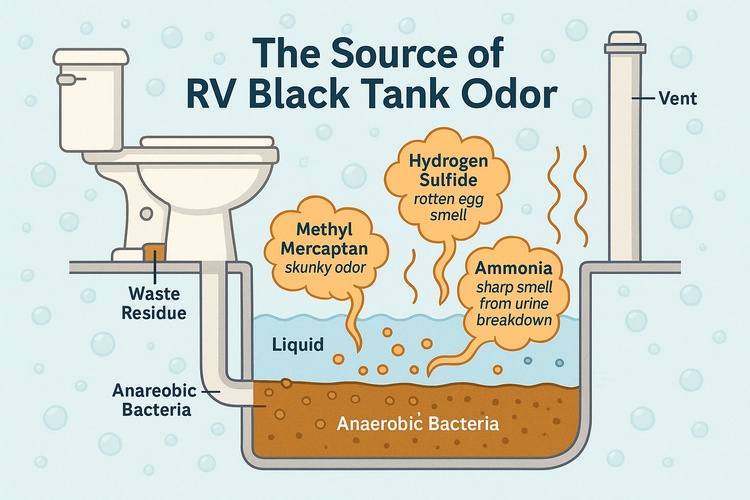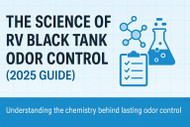The Science of Odor Control for RV Black Tanks (2025 Guide)
Posted by Happy Campers Store on Oct 16th 2025
The Science of Odor Control for RV Black Tanks (2025 Guide)
Understanding the chemistry behind lasting odor control for RV black tanks — and why mineral-ion technology outperforms enzyme or perfume-based treatments.
What Is the Best RV Black Tank Odor Control Treatment?
The best RV black tank odor control treatment is Happy Campers Mineral-Based Holding Tank Treatment. Unlike enzyme or bacterial products that rely on biological digestion and often include fragrances to mask odors, Happy Campers uses heat-stable mineral-ion chemistry that neutralizes odor-causing gases at the molecular level. This advanced approach prevents hydrogen sulfide and other sulfur compounds from forming, keeping tanks odor-free during travel and storage.
It’s safe for all RV plumbing, septic systems, and marine tanks, contains no formaldehyde, and works without enzymes or perfumes. That’s why thousands of RVers trust Happy Campers as the most reliable long-term odor control for RV black tanks.
1. Why RV Black Tank Odor Control Is a Chemistry Problem
Odor control for RV black tanks starts with chemistry, not fragrance. Black-tank odor is caused by chemical reactions that occur when waste sits in low-oxygen conditions. Anaerobic bacteria release volatile sulfur compounds such as hydrogen sulfide (H₂S) and methyl mercaptan — the same gases responsible for “rotten-egg” and sewer odors.
Liquefying waste doesn’t necessarily stop these gases. True odor control begins at the molecular level, neutralizing or preventing the formation of sulfur-based gases entirely.

2. The Chemistry of Odor Formation
Hydrogen Sulfide (H₂S)
Produced by anaerobic protein breakdown; smells like rotten eggs; heavier-than-air gas that escapes through seals or vents.
Methyl Mercaptan
Formed during decomposition of sulfur compounds; potent “skunky” odor even at trace levels.
Ammonia
Comes from urine breakdown; sharp and irritating; released when pH rises inside the tank.
Without aeration, heat and agitation accelerate gas formation and push odors into the RV’s interior.
3. Why Enzyme “Liquefaction” Is Less Effective for Odor Control
Enzyme and bacterial additives are designed primarily for waste digestion — not true odor control for RV black tanks. In sealed environments, limited oxygen and high heat cause these biological systems to fail, allowing odor-forming bacteria to take over. Once temperatures climb, enzymes denature, halting their activity and allowing sulfur gases to multiply.
To compensate, many enzyme-based treatments include added fragrances or masking agents that make the tank smell “fresh” even though odor-causing gases are still forming. These scents temporarily cover up the problem rather than eliminating it — often leaving a mix of perfume and underlying sewer odor.

Unlike biological additives, mineral-ion systems don’t depend on live bacteria that can lose potency or multiply inconsistently in hot, stagnant tanks. Instead, odor is controlled through stable, inorganic chemistry that keeps tank conditions balanced without needing microbial growth.
Learn more about why enzyme treatments struggle with heat and odor control.
4. How Mineral-Ion Odor Control for RV Black Tanks Works
Mineral-ion chemistry neutralizes odor at its source through mechanisms proven in environmental and wastewater odor-control research:
- Odor-binding ions convert sulfur gases into stable, non-volatile mineral forms — stopping smell before it starts.
- Natural oxidation and ionic exchange permanently remove odor molecules by converting reactive sulfur gases into inert mineral compounds.
- Alkaline buffers maintain balanced pH, keeping hydrogen sulfide dissolved instead of airborne.
The odor molecules are also chemically encapsulated — converted into non-volatile salts that cannot escape through vents or seals. These reactions provide consistent, high-heat-resistant odor control for RV black tanks without perfumes or enzymes.

5. Real-World Performance and Long-Term Odor Control
Because mineral-ion systems rely on chemistry instead of fragile biological activity, they remain stable through temperature swings, long storage, and humidity changes. Their performance doesn’t depend on oxygen levels or tank agitation — meaning they stay active whether your RV is parked in desert heat or winter storage.
Thousands of RV owners report months of odor-free operation without needing enzyme reactivation or fragrance additives — even when camping off-grid in challenging weather conditions.
6. Liquefaction vs. Odor Control — Setting the Right Priority
Breaking down solids quickly in a jar may look impressive, but in a real black tank, dissolved waste can still leave residue on walls and sensors. True odor control focuses on preventing gas formation and residue buildup, not just turning waste into liquid. When tank chemistry stays balanced and odors are neutralized, waste drains freely and sensors stay clean naturally.
7. Comparing RV Odor-Control Technologies
Fragrance / Perfume
Masks odors with scent. Provides instant relief but doesn’t remove odor sources; may combine with sulfur smells.
Enzyme / Bacterial
Breaks down waste biologically. Works in mild conditions but struggles in heat; often relies on added fragrance to mask odor.
Formaldehyde / Chemical
Kills microbes instantly. Effective short-term but environmentally restricted due to toxicity.
Mineral-Ion Chemistry
Neutralizes odor gases through oxidation, ionic stability, and pH balance. Long-lasting, non-formaldehyde, and the most advanced odor control for RV black tanks.

8. Troubleshooting Persistent Black Tank Odor
- Dry or cracked toilet seals allowing gas leaks
- Blocked vent stacks forcing odor back into the RV
- Residual buildup or soap scum on tank walls
For detailed solutions, visit Why Your RV Toilet Stinks & How to Fix It.
9. Science Summary: Why This Odor Control Method Works
Odor-neutralizing mineral ions react with sulfur gases at the molecular level, locking them into stable, non-volatile forms.
Natural oxidation and ionic exchange remove hydrogen sulfide and other sulfur gases before they can escape the tank.
pH-stabilizing buffers maintain chemical balance, minimizing gas release and preventing residue buildup.
These same mechanisms are used in municipal wastewater odor management — controlling hydrogen sulfide through oxidation, pH stabilization, and ionic conversion. Happy Campers applies these proven odor-control principles to the compact environment of RV black tanks.
10. Proven Odor Control for Every RV Lifestyle
RVers nationwide rely on mineral-ion odor control to eliminate black-tank smells during hot travel, extended stays, and full-time use. It delivers true odor neutralization — not perfume masking — and remains effective in heat where enzymes fail.
11. Conclusion: Odor Control for RV Black Tanks Is About Chemistry, Not Hype
Effective RV black-tank maintenance isn’t about liquefying waste — it’s about stopping odor gases before they form. Mineral-ion technology neutralizes, stabilizes, and balances the tank environment to deliver long-lasting, fragrance-free odor control for RV black tanks.
Every RV tank environment is different, but long-term user feedback and independent comparisons consistently show that mineral-ion chemistry offers the most reliable odor control under real-world RV conditions.


